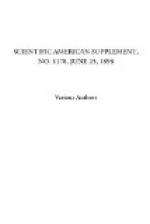On the trip of this ship to Cuba, no officer or man has ever worn a tunic excepting at guard mounting inspection. The 50 men who went ashore near Cabanas on May 12 and pitched into some 500 Spaniards left their coats behind and fought in their blue flannel shirts. Of the officers, some wore a sword, some did not, though all carried a revolver. No orders were issued on the subject—it was left to individual taste, I have experienced hotter days at German maneuvers than on the coast of Cuba during the days we happened to be there, yet I have never noticed any disposition in the army of William II. to relax the severity of service even temporarily. My German friends sincerely believe that the black stock and the hot tunic are what has made Prussia a strong nation, and to disturb that superstition would be a thankless task.
In the way of clothing the American private carries a complete change of under-drawers, under-shirt, socks, laced boots and uniform trousers. My particular private was carrying a double allowance of socks, handkerchiefs, and underwear. He had a toothbrush and comb. That is the heavy marching order knapsack. For light marching, which is the usual manner, the man begins by spreading on the ground his half-tent, which is about the size of a traveling rug. On this he spreads his blanket, rolls it up tightly into a long narrow sausage, having first distributed along its length a pair of socks, a change of underwear, and the two sticks of his one tent pole. Then he brings the ends of this canvas roll together, not closely, as in the German army, but more like the ends of a horse-shoe, held by a rope which at the same time stops the ends of the roll tightly. When this horse shoe is slung over the man’s shoulder, it does not press uncomfortably upon his chest. The total weight is distributed in the most convenient manner for marching.




